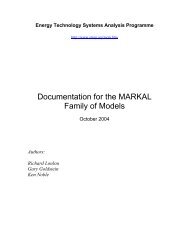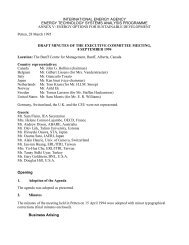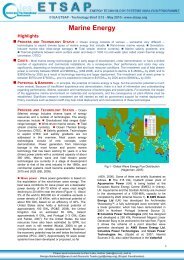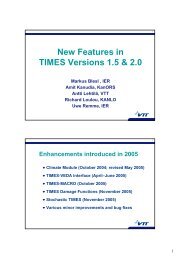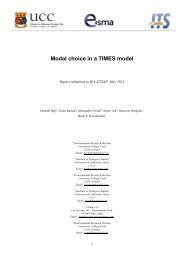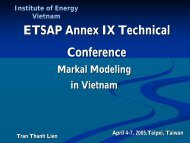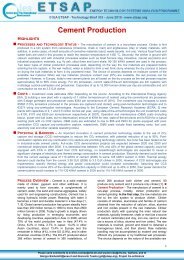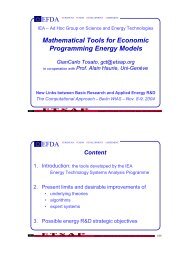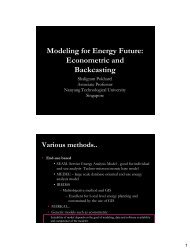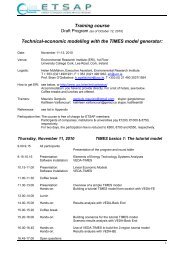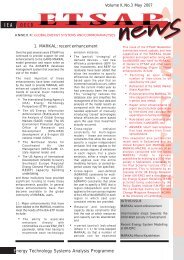Sets and Parameters - iea-etsap
Sets and Parameters - iea-etsap
Sets and Parameters - iea-etsap
You also want an ePaper? Increase the reach of your titles
YUMPU automatically turns print PDFs into web optimized ePapers that Google loves.
Based on the storage characterization given by prc_stgips, prc_stgtss or prc_nstts for a<br />
process p, internally a prc_map(r,’STG’,p) entry is generated to put the process in the group<br />
of the storage processes. A further prc_map entry is created to specify the type of storage<br />
(‘STK’ for inter-operiod storage, ‘STS’ for time-slice storage <strong>and</strong> ‘NST’ for a night-storage<br />
device).<br />
2.2.1.2 Commodities<br />
As mentioned before the set of commodities ( c ) is a subset of the commodity group set (cg).<br />
A commodity in TIMES is characterised by its type, which may be an energy carrier (‘NRG’),<br />
a material (‘MAT’), an emission --or environmental impact (‘ENV’), a dem<strong>and</strong> commodity<br />
(‘DEM’) or a financial resource (‘FIN’). The commodity type is indicated by membership in<br />
the commodity type mapping set (com_tmap(r,com_type,c)). The commodity type affects<br />
the default sense of the commodity balance equation. For NRG, ENV <strong>and</strong> DEM the<br />
commodity production is normally greater than or equal to consumption, while for MAT <strong>and</strong><br />
FIN the default commodity balance constraint is generated as an equality. The type of the<br />
commodity balance can be modified by the user for individual commodities by means of the<br />
commodity limit set (com_lim(r,c,lim)). The unit in which a commodity is measured is<br />
indicated by the commodity unit set (com_unit(r,c,units_com)). The user should note that<br />
within the GAMS code of TIMES no unit conversion, e.g., of import prices, takes place when<br />
the commodity unit is changed from one unit to another one. Therefore, the proper h<strong>and</strong>ling<br />
of the units is entirely the responsibility of the user (or the user interface).<br />
2.2.2 Definition of the time structure<br />
2.2.2.1 Time horizon<br />
The time horizon for which the energy system is analysed may range from one year to many<br />
decades. The time horizon is usually split into several periods which are represented by socalled<br />
milestone years (t(allyear) or milestonyr(allyear), see Figure 5). Each milestone year<br />
represents a point in time where decisions may be taken by the model, e.g. installation of new<br />
capacity or changes in the energy flows. The activity <strong>and</strong> flow variables used in TIMES may<br />
therefore be considered as average values over a period. The shortest possible duration of a<br />
period is one year. However, in order to keep the number of variables <strong>and</strong> equations at a size<br />
that can be processed by the current solution <strong>and</strong> reporting software as well as computer<br />
hardware a period usually comprises several years. The durations of the periods do not have<br />
to be equal, so that it is possible that the first period, which usually represents the past <strong>and</strong> is<br />
used to calibrate the model to historic data, has a length of one year, while the following<br />
periods may have longer durations. Thus in TIMES both the number of periods <strong>and</strong> the<br />
duration of each period are fully under user control. The beginning year of a period<br />
B(allyear), its ending year E(allyear), its middle year M(allyear) <strong>and</strong> its duration D(allyear)<br />
have to be specified as input parameters by the user (see Table 12 in subsection 3.1.3), except<br />
for past years where B=E=milestonyr.<br />
To describe capacity installations that took place before the beginning of the model<br />
horizon, <strong>and</strong> still exist during the modeling horizon, TIMES uses additional years, the socalled<br />
past years (pastyear(allyear)), which identify the construction completion year of the<br />
already existing technologies. The amount of capacity that has been installed in a pastyear is<br />
specified by the parameter NCAP_PASTI(r,allyear,p), also called past investment. For a<br />
process, an arbitrary number of past investments may be specified to reflect the age structure<br />
in the existing capacity stock. The union of the sets milestonyr <strong>and</strong> pastyear is called<br />
modelyear (or v). The years for which input data is provided by the user are called datayears<br />
(datayear(allyear)). The datayears do not have to coincide with modelyears, since the<br />
preprocessor will interpolate or extrapolate the data internally to the modelyears. All<br />
20



